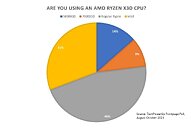- Joined
- Oct 9, 2007
- Messages
- 47,164 (7.57/day)
- Location
- Hyderabad, India
| System Name | RBMK-1000 |
|---|---|
| Processor | AMD Ryzen 7 5700G |
| Motherboard | ASUS ROG Strix B450-E Gaming |
| Cooling | DeepCool Gammax L240 V2 |
| Memory | 2x 8GB G.Skill Sniper X |
| Video Card(s) | Palit GeForce RTX 2080 SUPER GameRock |
| Storage | Western Digital Black NVMe 512GB |
| Display(s) | BenQ 1440p 60 Hz 27-inch |
| Case | Corsair Carbide 100R |
| Audio Device(s) | ASUS SupremeFX S1220A |
| Power Supply | Cooler Master MWE Gold 650W |
| Mouse | ASUS ROG Strix Impact |
| Keyboard | Gamdias Hermes E2 |
| Software | Windows 11 Pro |
AMD Ryzen processors with 3D Vertical Cache technology, denoted with the "X3D" brand extension on processor model numbers, are showing unexpected popularity numbers with close to a quarter of respondents to a TechPowerUp Frontpage Poll question saying that they use one. In August, we asked our readers if they use a Ryzen X3D processor. The question was "Are you using an AMD Ryzen X3D CPU with 3D V-Cache?" This was a few months into the launch of the Ryzen 7000X3D processor series that restored the gaming performance leadership for AMD against Intel's 13th Gen Core "Raptor Lake" processors.
Since the poll went live in August, we've seen 31,862 responses. From these, 14,732, or 46% say that they use a classic Ryzen processor (one without 3D V-cache). followed by 9,780 or 31% saying they use an Intel processor; an impressive 4,316 or 14% saying they use a Socket AM4 Ryzen 5000X3D series processor (5800X3D or 5600X3D); followed by 3,034 or 10% saying they use the latest 7000X3D series "Zen 4" processors. The X3D series together make 7,350 votes, or 23%.

The 3D Vertical Cache technology involves enlarging the last-level L3 cache of the processor by stacking the serious of the processor's 7 nm "Zen 3" or 5 nm "Zen 4" CPU core die (CCD) with a 64 MB L3 cache die (L3D) built on the 6 nm process. This die operates at the same performance as the on-die 32 MB L3 cache, and hence adds to it as a 96 MB continuously addressable cache block visible to software. This large amount of fast memory sitting close to the CPU cores allows a larger amount of game data to be stored at a significantly faster storage medium than the DDR4/DDR5 main memory, resulting in tangible gaming performance improvements. Depending on the game, these range anywhere between -2% to 23%.
The Ryzen 7 5800X3D is an exceptionally popular processor, as it allows those on the older Socket AM4 platform to achieve gaming performance on-par with a newer desktop powered by a Core i9-12900K "Alder Lake" processor (around 15% to 20% higher gaming performance than a regular 5800X). AMD's first Ryzen 7000 processors roughly match the 5800X3D in gaming performance despite lacking 3D V-cache, on the backs of improved IPC of the "Zen 4" cores, and faster DDR5 memory, but were swiftly beaten by the 13th Gen Core "Raptor Lake." AMD responded with the 7000X3D processors, which restore the gaming performance leadership over the 13th Gen, with the 7800X3D in particular being the fastest gaming processor that's widely available.
View at TechPowerUp Main Site | Source
Since the poll went live in August, we've seen 31,862 responses. From these, 14,732, or 46% say that they use a classic Ryzen processor (one without 3D V-cache). followed by 9,780 or 31% saying they use an Intel processor; an impressive 4,316 or 14% saying they use a Socket AM4 Ryzen 5000X3D series processor (5800X3D or 5600X3D); followed by 3,034 or 10% saying they use the latest 7000X3D series "Zen 4" processors. The X3D series together make 7,350 votes, or 23%.

The 3D Vertical Cache technology involves enlarging the last-level L3 cache of the processor by stacking the serious of the processor's 7 nm "Zen 3" or 5 nm "Zen 4" CPU core die (CCD) with a 64 MB L3 cache die (L3D) built on the 6 nm process. This die operates at the same performance as the on-die 32 MB L3 cache, and hence adds to it as a 96 MB continuously addressable cache block visible to software. This large amount of fast memory sitting close to the CPU cores allows a larger amount of game data to be stored at a significantly faster storage medium than the DDR4/DDR5 main memory, resulting in tangible gaming performance improvements. Depending on the game, these range anywhere between -2% to 23%.
The Ryzen 7 5800X3D is an exceptionally popular processor, as it allows those on the older Socket AM4 platform to achieve gaming performance on-par with a newer desktop powered by a Core i9-12900K "Alder Lake" processor (around 15% to 20% higher gaming performance than a regular 5800X). AMD's first Ryzen 7000 processors roughly match the 5800X3D in gaming performance despite lacking 3D V-cache, on the backs of improved IPC of the "Zen 4" cores, and faster DDR5 memory, but were swiftly beaten by the 13th Gen Core "Raptor Lake." AMD responded with the 7000X3D processors, which restore the gaming performance leadership over the 13th Gen, with the 7800X3D in particular being the fastest gaming processor that's widely available.
View at TechPowerUp Main Site | Source









 . In any case this is an enthusiast forum, so users should derive from the average.
. In any case this is an enthusiast forum, so users should derive from the average.